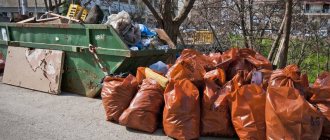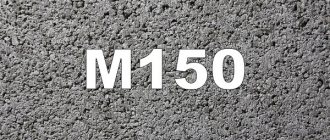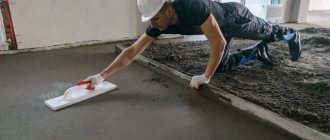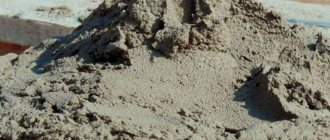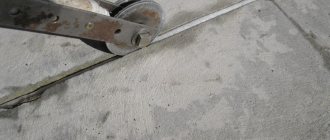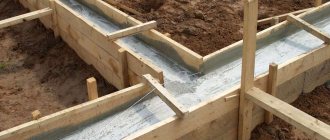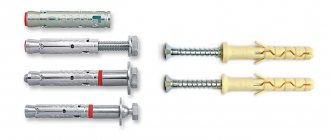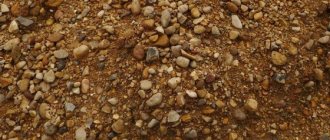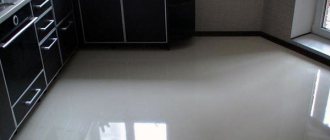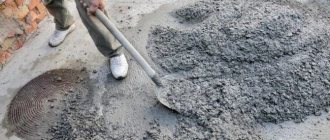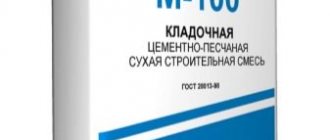What kind of products are there in the modern assortment of concrete plants! Due to the rapid development of the industry, new building materials are constantly appearing.
Many of us don’t even know about their existence, let alone their properties and applications. This is approximately the situation with such names as sand concrete and cement-sand mixture. Some builders confuse or combine these concepts, but in vain. These are different building materials. Today we’ll talk about how they differ and where they are used.
How do they differ in composition?
Cement is an artificial material that, when interacting with water, forms a plastic mass called cement mortar. It contains crushed clinker, gypsum, as well as all kinds of technical additives. The properties of the future hardened material depend on the amount of fillers in the dry mixture. In particular, moisture resistance, strength, speed of hardening and others.
Concrete is another artificial building material, one of the components of which is cement. It performs an astringent function. So, the composition of the building mixture must include:
- cement;
- sand;
- water;
- crushed stone
To enhance any properties of concrete, plasticizers and water repellents are added to it.
Important! Crushed stone of large or small caliber acts as a filler in concrete, while in cement this role is assigned exclusively to sand. Hence the first obvious conclusion - concrete is many times stronger than cement mortar.
Sand concrete is a new material that appeared in the construction industry relatively recently, but has already gained popularity. The raw materials have excellent resistance to external factors and are particularly durable. It is easy and convenient to use for all types of construction work. You can prepare the sand concrete solution right before pouring the screed. First, pour the dry mixture into a container, add water and beat with a mixer. There is no need to monitor proportions, unlike a mixture of cement and concrete.
Sand concrete is mistakenly classified as cement mortar. This is due to the fact that in the composition of common sand concrete mixtures M 300, this component is in second place. But when mixing, in addition to sand and concrete, small fraction crushed stone is often added to the material, which gives sand concrete its second name - fine-grained concrete.
Traditional production of cement-sand mortar.
Advantages:
- relatively low price for all components of the solution;
- availability of solution components.
Flaws:
- half of the cement available for sale in Ukraine is counterfeit (according to the Ukrcement Association), which automatically increases the likelihood of efflorescence and stains on the front surface of the brick and reduces the strength of the finished masonry;
- it is necessary to additionally purchase plasticizers to improve the mechanical properties of the cement-sand mortar;
- difficulty in controlling the quality of the solution, i.e. compliance with the technology of its preparation - the proportions of the mixture, the quality of the cement used, water, etc.;
- increased risk of obtaining masonry mortar that does not meet quality standards, which in turn leads to a decrease in the strength of the entire finished masonry;
- in order to obtain masonry mortar of a quality close to ready-made masonry mixtures, it is necessary to find and purchase sifted coarse sand without clay impurities;
- To obtain a uniformly colored seam, all components must be dosed very carefully, and this leads to an increase in the masonry time.
Areas of use
Which building materials to buy depends on their area of application. The more precisely the task is set, the easier it will be to choose what to use - cement mortar or sand concrete.
Where is cement used?
Cement holds wall building elements together during masonry. For example, concrete blocks, brickwork, floor slabs.
Cement is also suitable for:
- plastering and painting works;
- filling joints between brickwork and slabs;
- pouring floor screed;
Depending on the choice of fraction, the material will have different strength.
Where is concrete used?
This material is used in such areas of construction as:
- production of load-bearing structures;
- pouring the foundations of residential and industrial buildings;
- production of reinforced concrete products.
Often the mixture is necessary for special types of work - hydraulic engineering, thermal insulation, road and even decorative.
Where is sand concrete used?
At different stages of building a house, sand concrete is simply irreplaceable. First of all, it is used to fill the foundation screed to create a reliable foundation for the structure. The material is then used for the following purposes:
- production of floor screeds and laying of coverings;
- construction of load-bearing structures, wall and basement blocks;
- fastening piles, tiles and well rings;
- production of reinforced concrete products (stairs, road and floor slabs, fences for loggias);
- decorative design of premises.
Where are DSP and sand concrete used?
Cement-sand mixture is in demand in construction , as well as in repair, plastering and finishing work. When choosing a material, it is necessary to take into account the ratio of cement and other components. The scope of use depends on the brand of the mixture:
- M100 - plastering work, finishing;
- M150 - finishing, puttying and leveling of various surfaces;
- M200 - concreting the subfloor, pouring reinforced concrete products, finishing work.
Sand concrete has a uniform consistency and is suitable for manual construction, repair and finishing work:
- concreting floor screeds, staircases;
- bricklaying, fastening of reinforced concrete structures;
- plastering work, sealing joints.
When introducing water into the composition, safety precautions should be observed: use gloves when working with the mixture, kneading should be done in a dry room with a temperature of +5 to +30°C.
produces and sells high quality building mixtures at competitive prices. You need to quickly bring concrete, sand concrete or cement-sand mixture to the site - call. We will deliver the order on time and in the required quantity. All products have certificates of conformity and passports for each batch of goods.
Which material is better
Leveling the floor surface with concrete is a classic option that has long been used in the construction industry. But even reinforcing concrete screeds with metal or composite mesh will never give the effect that sand concrete provides. The new universal material is very cheap. For example, the price for baumax M300 50 kg sand concrete is two times lower than for the same bag of concrete. At the same time, it combines several features:
- high strength;
- non-shrinkability;
- plastic;
- frost resistance;
- sound insulation;
- thermal insulation;
- waterproof.
The pouring technology of this building material is also superior to its competitors. When laying the foundation, the popular sand concrete Stone Flower M300 requires only leveling. The strength of the resulting surface will correspond to the marking - it will withstand a load of up to 300 kg/m3.
Thus, if you choose between concrete and sand-concrete screed, professionals are more likely to choose the second. It is more durable, more practical and economical.
Video description
How to make a screed on expanded clay to reduce the load on the base, watch the video:
Ready-made formulations
Ready-made floor screed mortar is not sold in stores, but you can buy a dry mixture and simply dilute it with water according to the instructions, without choosing the proportions. This is very convenient: you don’t need to separately purchase plasticizer, cement and sand, sift it, carry it in buckets to a concrete mixer, and take into account its moisture content when adding water. But you will have to pay more for convenience. How much depends on the composition of the mixture, which may include a variety of improving additives. For example, fiberglass that reinforces the screed, or polystyrene foam granules that lighten it.
Such mixtures have many advantages over homemade ones.
- They are easy to knead with a construction mixer or a drill with an attachment in a container of suitable volume.
- Most of them can be laid in a thinner layer than required by construction requirements, without losing the strength of the created coating.
- They are self-leveling and require less effort to create a level, level surface.
Smooth, smooth and durable screed from the finished mixture Source materik-m.ru
Why is it profitable to buy building materials from AlfaCem?
You will not find such a large selection of high quality building materials in Moscow anywhere as in the group. Here you can buy M300 sand concrete of famous domestic and foreign brands. Among them are proven ones:
- Baumax;
- Dauer;
- Stone Flower;
- Installation Plus.
The catalog contains bags weighing 20, 25, 40 and 50 kg for long-term and short-term construction work. Minimum shipment – 40 bags of any volume.
Hundreds of construction companies and individuals are already cooperating with AlfaCem. They buy sand concrete mixture from the manufacturer on a regular basis. Benefits we offer:
- Quality and range. All suppliers of building materials are carefully selected and only those who offer the best products are included in the catalogue;
- Large volumes. Through the website you can order dry construction mixtures in any quantities from 1 pallet to several tons;
- Reasonable price. The price list is constantly updated, and discounts are provided for large wholesale purchases of sand concrete;
- Prompt delivery. Bags of cement mixtures are continuously delivered directly from a warehouse in Moscow throughout Russia;
- Professionalism. A qualified team is ready to help the client at every stage from selecting products to arranging delivery.
If you are interested in purchasing sand concrete M300 in small and large wholesale, you can get detailed advice by phone or online. The application form is available 24 hours a day.
Sand concrete: types, composition, characteristics, brands, consumption, photo, description, review
During the construction process, various types of concrete are used, which differ in strength, specific gravity and other characteristics.
Among the building materials popular nowadays, it is worth highlighting sand concrete.
Mixtures of this type are easy to both produce and use, and in both cases they are economically beneficial.
According to the classification of the state standard GOST 7473-94 “Concrete mixtures. Technical conditions", sand concrete belongs to fine-grained concrete mixtures (FCM), and according to its intended purpose - to structural concrete and has the characteristics indicated in the tabular data.
In accordance with GOST 7473-94 “Concrete mixtures. Technical specifications”, according to the degree of preparation of the mixture, are divided into the following types:
- ready-to-eat (RBG);
- dry mixes (DSM).
Based on workability, mixtures are divided into groups:
- super-hard (SZh);
- hard (F);
- movable (P).
Concrete mixtures are classified as follows:
- concrete mixtures of lightweight concrete (LBC),
- concrete mixtures of fine-grained concrete (BSM),
- concrete mixtures of heavy concrete (BCT).
The marking of a concrete mixture consists of an abbreviated designation of the mixture by readiness, type and class of concrete by strength, grade by workability, frost resistance, water resistance, medium density (for lightweight concrete) and the designation of the standard.
For example, BSG V25 P1 F200 W4 GOST 7473-94 is deciphered as follows:
- BGS – ready-mixed concrete mixture of heavy concrete;
- B25 – compressive strength class (in MPa);
- P1 – grade for workability;
- F200 – frost resistance grade;
- W4 – waterproof grade.
Mixtures of this type are easy to both produce and use, and in both cases they are economically beneficial.
Characteristics of consistencies
Dry mixtures for floor screeds are significantly superior in technical data to cement mortar screeds. The base is very strong and reliable, capable of serving for a long time. The finished floor screed is installed without cracking; the main thing is to follow the technology of the process itself. It is very simple to use and does not require any advanced knowledge.
Just add the required amount of water and get to work.
In any case, the manufacturer himself points out preliminary measures and rules for using the finished consistency. There are proper tips that should be followed so that all characteristics are maintained. This is very important in terms of adding water. With a larger quantity, the property and strength of the surface becomes lower.
High-quality consistencies are distinguished by the absence of cement “milk”. There should not be any sediment or impurities. The structure of the finished solution must be uniform.
Work can be carried out one by one, in several steps. In this case, the floors must be filled with a dry consistency without leaving space between the seams. As a result, there will be no shrinkage if the best dry mixtures for floor screed are selected and all requirements from the manufacturer are met.
Varieties of dry consistencies
There are several types of ready-made compounds that are used for pouring screed.
Cement-based liquid mixtures
Although this category contains cement, it differs significantly from the usual version. The differences lie in the addition of mineral and synthetic fillers and special modifiers. Such compositions are divided into subtypes, differing in method of use:
- Pre-smoothing products. This material contains a sand mixture of a large fraction and granite chips. Almost all craftsmen consider this solution to be good for pouring a coating under a warm floor with a resulting width of 30 to 80 mm. It should be taken into account that the finished structure needs additional smoothing.
- Self-leveling mixtures for final floor filling. They contain the smallest fraction of sand and special plasticizers. The resulting surface is impeccably smooth and is one hundred percent ready for the next cladding. This particular option is ideal for creating thin thicknesses of 4–5 mm. To increase reliability, fiber or fiberglass reinforcing mesh is used.
- Self-leveling compounds. This material contains a small fraction of substances; it is suitable only for creating a final coating 3–5 mm wide. Drying requires a short amount of time, but the products have a fairly high price.
- With a special mixture for pouring heated floors. Naturally, you can use other options for this, but only this solution helps to get the best result. It's all about increased plasticity, which is achieved only through correctly selected components.
